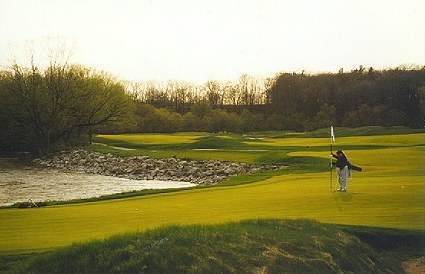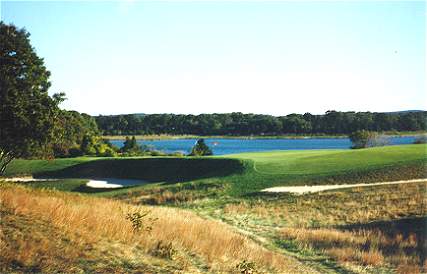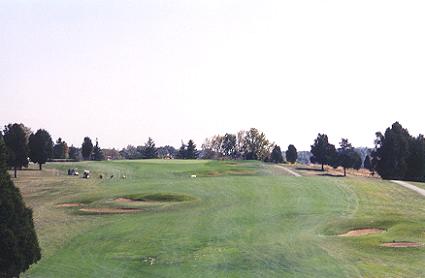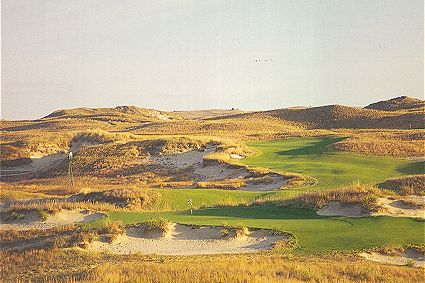Feature Interview with Tim Liddy
August 2000
Tim Liddy, a resident of Indiana, has been in golf his entire life. He grew up working on a golf course and started working with Pete Dye over 13 years ago. He presently divides his time between working with Mr. Dye and his own firm, Tim Liddy / Associates, Inc. His most recent designs at TheTrophy Club and Rock Hollow in Indiana met with immediate praise. Also, Tim’s remodelling effort to expand Harrison Hills to an 18 hole course was a significant achievement for such an intimidating task . For further information, go to www.timliddy.com.
1. Please select a favorite hole that you have built and detail what you like so much about it.
It is always hard to pick a favorite golf hole. They are like picking a favorite child – impossible.
How about a favorite design concept?
One of my favorite strategic design concepts is a Par 4 (sometimes a par 5) that flows one way off the tee and then turns back the opposite direction into the green. This reversing of shots (draw off the tee, cut into the green for example) were Donald Ross’s best holes and he always used the natural terrain very effectively to achieve this great concept.
I have used this concept on several of the golf holes at Trophy Club in Lebanon, Indiana (Holes, #3, #12 and #15) and Rock Hollow (#7, #9, #12 and #16) in Peru, Indiana.
In general, golf holes represent the best collaborative thought that an architect, client and craftsmen have at that given time and budget.
It is funny, but many times I see the struggles, events, battles and relationships that each hole presented. I usually have a strong idea or two about a hole under construction and am normally working with a very talented craftsmen and owner. When I come back and play my holes, I not only enjoy the golf hole, but also many times relive the long hours, hard work and obstacles we overcame to build the golf hole. Many times it is the expression of a workers dirty face as he sees me walking up the new fairway or green waiting anxiously for my comments.
The dream is that each hole is shaped lovingly by craftsmen. I have been fortunate to be involved in a few golf courses that were built this way.
2. Is there a particular aspect in your work that you seem to do differently than most of the other modern architects?
If I have a signature, I am sure it is my influence from Pete Dye and his great ability in the horizontal layout of golf holes. Without question, Mr. Dye is the best architect practicing today that achieves the correct horizontal layout of a golf hole every time (Raynor was also very good at this). If a golf hole does not play well it is almost always due to a mistake from the architect on the proper horizontal layout of a golf hole-how it lays on the ground. The vertical is easy, and just about anybody can build vertical, but how the golf hole lays on the ground is the foundation of a golf hole being bad, good, or great. I feel my better golf holes exhibit this trait.
I also think a common trait of my design is rewarding the player that can maneuver the golf ball. This identifies the golfer with the greater ability. It also battles the onslaught of straighter golf balls, titanium trampolines, and graphic whipping post.
Finally, I am very proud that my golf courses are very affordable to build, which translates into affordable green fees, typically in the $50 range.

A great horizontal layout – the 12th at Blackwolf Run River Course.
3. How do the advances in both equipment and turf influence your design?
The advances in turf equipment and turf really promote the importance of the superintendent in today’s golf course. I count on superintendents tremendously, especially on remodeling work, because of their no nonsense, direct approach in design and maintenance. I always have the superintendent on my jobs involved in the final areas of fly-mow, etc. so they are comfortable with the amount of future maintenance that will be involved.
Of course the biggest change that equipment and turf have today is the ability to mow greens at very, very low heights. Green speed is something I worry about on every job. When Hogan won the open at Oakmont in 1953 (the notorious fastest greens at that time), the greens rolled at about 6 on a stipmeter, putting into the grain. Today, we have no grain and common speeds are 10 to 12 feet. Obviously, greens have to be flatter or larger (or both) to allow the ball to run and stop off of slopes (and stay on the greens). I prefer small undulating greens and do not mind if a ball occasionally runs off the green if hit into the wrong area of a green, but green areas for cup placement are today much flatter than Ross or Mackenzie every thought about building on their greens. This definitely changes the look of the greens, no matter how they are shaped, and have ruined many existing Raynor and Mackenzie greens (renovated?) done by experts.
I find my best greens built today are greens that are relatively flat, but look like they have a lot of movement. Putts look like they will break away from the hole, but do not break any substantial amount.
4. How much time do you find for studying other courses?
I am obsessed with golf course architecture.
Visits to great golf courses feed my spirit and provide motivation.
I find the best time to study other courses is in the winter months when there is no snow cover in the Midwest. Superintendents are always great in allowing me to walk around and brief me on particulars. Also, there are usually few players to bother on the golf course. I have been fortunate to play many great courses, which is important in understanding their nuances.

Raynor’s Shoreacres in the Midwest is a most rewarding course to study.
I find visiting an old classic golf course as one of the greatest joys in life. It answers the direct question of what is beauty. It is simplistic to expect a single right answer.
5. Where do you get your inspiration for new designs?
The art of building golf courses is a serious and searching business.
I always have a research phase in my design process. It is normally after the routing has been approved. I will take my preliminary thoughts for a golf hole and research through books, my library of notes and photos, etc. to generate a strong concept (or two) for each golf hole. These concepts always change or evolve, but it inspires me and provides me with a solid foundation to begin construction.
Of course a main inspiration for me is talking (listening) with Pete and Alice Dye about golf holes, how pros, golfers play them, etc. They are a great inspiration and support to me.
6. On which courses have you worked with Pete Dye? What aspects of his design do you admire? What’s you favorite Dye course?
I have worked with Pete Dye on many golf courses, normally in the routings stages. I draw many of his preliminary drawings for projects, but please know they are his ideas. I am just the draftsman. I have been a project architect on a few of his projects. They include: The Fort, in Indianapolis, Indiana, Avalon Lakes, in Youngstown, Ohio, Purdue Golf Course, Lafayette, Indiana, and a few others. I am currently acting as project architect on two jobs in Bloomfield, Connecticut and Carmel, Indiana.
My favorite Dye course is normally the one I am working on. They are all very special.
7. Explain the challenge you felt when adding ten holes to Harrison Hills (Attica, Indiana). There must have been more pressure than just starting from scratch?
It was an extreme challenge. It was very intimidating. It was/is a great arrangement of golf holes. I wanted the project to feel like it had all been built at one time, and look like Langford had completed the entire job. I wanted it to look like I had never been there. On many of the holes I achieved that feeling. A few need more work. I am planning to go back this fall and tweak a few bunkers to expand on his style (take some of the dozer look out of them).
I feel it works very well, and will only get better over time.
8. If time or expense weren’t considerations, which five courses would you most like to see for the first time?
Because I live in the Midwest, I have yet to see many of the great courses in the west and west coast ( I have been to Scotland and Ireland, and have played many golf courses on the east coast). The five on my list to see are:

George Thomas’s Riviera – the 10th (pictured) is often sited as the finest short two shot hole in the country
- Riviera
- Sand Hills,
- Prairie Dunes,
- Cypress Point,
- San Francisco Golf Club,
- etc.etc.
9. The major golf publications all offer their version of the country’s best courses. As an architect, how much importance do you place on these rankings?
Rankings are always somewhat subjective and that is OK with me. They are great in furthering the art of golf course architecture through analysis, discussion and comment. I have my personal bias on some golf courses, some like vanilla, some like chocolate, but to debate these differences, styles, techniques, beauty, etc. through these rankings is more important than the rankings themselves. I think they have elevated the art of golf course architecture immensely over the past twenty years.
Factors that confuse the rankings are the clubhouse architecture, exclusivity, and the mystic of the place. It is not necessarily the best collection of golf holes.
10. What five holes (from different courses) do you wish you could say you designed?
I would probably pick 5 holes that I feel have had the greatest impact on either changing golf course design or furthering an important concept:

THE Redan
- #4 The National “ who hasn’t copied this North Berwick gem
- #14 Pinhurst “ strategic golf design 101
- #17 Muirfield “ a lesson for a great par five
- #5 Royal Melbourne “ how do you define beauty?
- #17 Harbour Town “ turning point in golf architecture
Many more, I should further define as American classics, per 1900 classics, etc, but you only ask for five.
11. What course is a personal favorite with which perhaps the readers may not be familiar? What do you like about it so much?
The Broadmoor Country Club in Indianapolis impresses me every time I visit it. It was built in 1921 by Donald Ross and has not been touched since, except for trees and irrigation. I am humbled every time I am there because of its great detail, routing and variety of golf holes. I love the proportions, the bunkering detail, the green contouring, everything. It is wonderful. I would put it up against any Donald Ross course in the country (except Pinehurst #2). To know it was built in 1921 is a great lesson to me that many times less is more.
12. Who are your three favorite architects of all time and why.
a) Pete Dye- a great mentor, great concepts, great thought process. I owe everything in this profession to him.
b) Donald Ross- had a great knowledge of the game, great routings, shot balance, variety, wonderful lessons on working with the natural topography.

Ross’s French Lick is in Tim’s home state of Indiana – pictured here is the mighty 18th.
c) Seth Raynor- attention to detail, juxtaposition of architecture against nature, great variety of green complexes.

The juxtaposition of art against nature – the 7th at Fishers Island
Many more, but you said three.
13. How do you think the period in course architecture (1985-1999) will be viewed in fifty year’s time?
I think this period of golf course architecture will have a few great golf courses (like many of the other periods). Although we are building many courses during this period, there are still only a few truly great projects that will compete with the great projects from the past.
Today, as in the past, there is a limited supply of talent, expertise, and knowledge of the details and ideas behind great golf courses. There are only a very few people who truly understand the very best of golf course architecture. Fewer still that have the artistic ability and knowledge to build them.

Sand Hills is one of the few truly great projects to emerge in the past fifteen years.
14. How did you and Pete Dye work together at The Fort?
I was the project architect. This involves running the project on a day-to-day basis and all that it entails (drawings, permits, bidding, etc.) I also assisted Mr. Dye on the design. This would involve roughing the golf holes in, per his guidance and following-up on his design refinements. Mr. Dye is very hands “on during the design of a golf course, which makes it very enjoyable for all involved. It was great working with him on the Fort, on a great piece of property.
15. How would you account for Indiana attracting so many of the finest modern architects?
‘Indiana-no-place’ is a on the way to everyplace else. Indiana suffers from not having a great natural recreational amenity like an ocean, lake or mountains. It does have gently rolling terrain that makes for great golf. People in Indiana like to play golf and it has become a major recreational activity.
16. The 6th Hole at the Trophy Club (Lebanon, Indiana) is flat; what inspired you to build the fascinating, rolling three-level green on that hole?
This golf hole occurred in the sequence of the golf round that I wanted to be very challenging. I felt the best way to achieve this was at the green. I started with the Biarritz green concept and took off from there to develop a challenging green site.
17. Tell us about your latest design.
I am currently working on an 18 hole course in Greenwood, Indiana (just south of Indianapolis) that has the best looks I have developed to date. It is a housing development in which the housing needed to bring about ½ million yards to the golf course. We have carved bunkers and carved bunkers. It really looks great.
18. Par five holes seem to be the most difficult to design, yet yours (e.g., all four at The Trophy Club, 5 and 7 at Harrison) are quite good. What are the keys to designing varied and interesting three shotters?
Thanks. First, it takes a lot of land to build a good par five (especially a lot of width) and in Indiana that is usually not a problem. I have been blessed with sites that have been generous with their acreage. Second, the horizontal layout I mentioned before is critical, as well as studying the great par fives of the past (Muirfield’s are a good start). An important aspect in all great par fives, is that you can see the green from the tee, enabling the holes strategy to unfold on the tee.
The End








